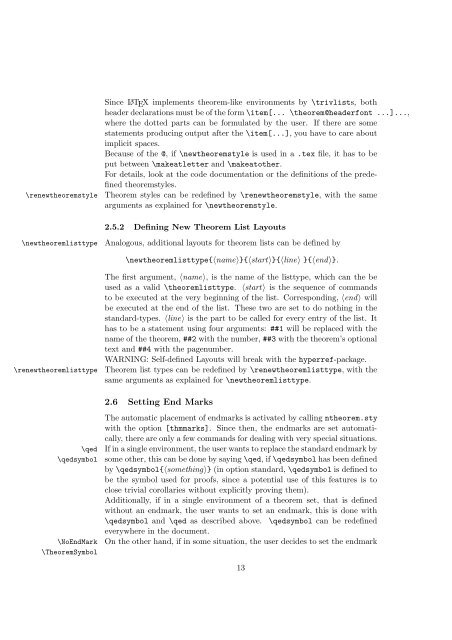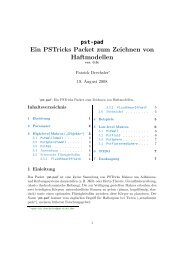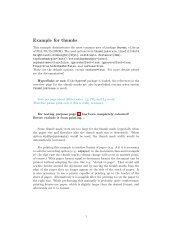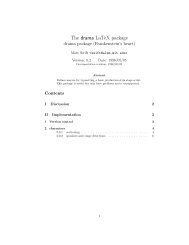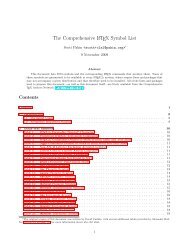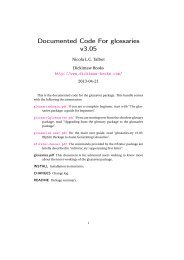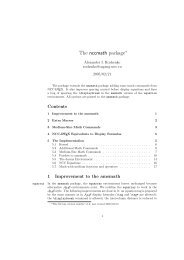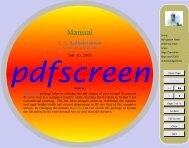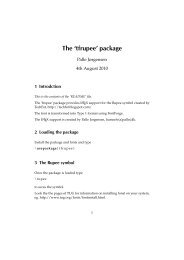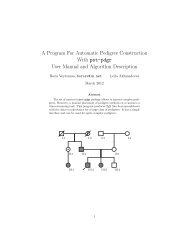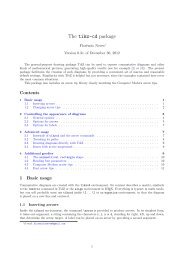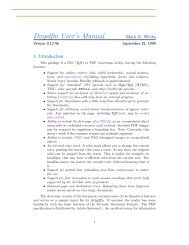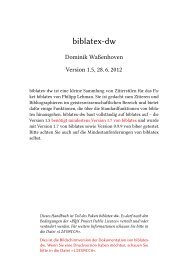ntheorem.pdf. - Mirrors.med.harvard.edu
ntheorem.pdf. - Mirrors.med.harvard.edu
ntheorem.pdf. - Mirrors.med.harvard.edu
You also want an ePaper? Increase the reach of your titles
YUMPU automatically turns print PDFs into web optimized ePapers that Google loves.
\renewtheoremstyle<br />
\newtheoremlisttype<br />
\renewtheoremlisttype<br />
\qed<br />
Since LATEX implements theorem-like environments by \trivlists, both<br />
headerdeclarationsmustbeoftheform\item[... \theorem@headerfont ...]...,<br />
where the dotted parts can be formulated by the user. If there are some<br />
statements producing output after the \item[...], you have to care about<br />
implicit spaces.<br />
Because of the @, if \newtheoremstyle is used in a .tex file, it has to be<br />
put between \makeatletter and \makeatother.<br />
For details, look at the code documentation or the definitions of the predefined<br />
theoremstyles.<br />
Theorem styles can be redefined by \renewtheoremstyle, with the same<br />
arguments as explained for \newtheoremstyle.<br />
2.5.2 Defining New Theorem List Layouts<br />
Analogous, additional layouts for theorem lists can be defined by<br />
\newtheoremlisttype{〈name〉}{〈start〉}{〈line〉 }{〈end〉}.<br />
The first argument, 〈name〉, is the name of the listtype, which can the be<br />
used as a valid \theoremlisttype. 〈start〉 is the sequence of commands<br />
to be executed at the very beginning of the list. Corresponding, 〈end〉 will<br />
be executed at the end of the list. These two are set to do nothing in the<br />
standard-types. 〈line〉 is the part to be called for every entry of the list. It<br />
has to be a statement using four arguments: ##1 will be replaced with the<br />
name of the theorem, ##2 with the number, ##3 with the theorem’s optional<br />
text and ##4 with the pagenumber.<br />
WARNING: Self-defined Layouts will break with the hyperref-package.<br />
Theorem list types can be redefined by \renewtheoremlisttype, with the<br />
same arguments as explained for \newtheoremlisttype.<br />
2.6 Setting End Marks<br />
The automatic placement of endmarks is activated by calling <strong>ntheorem</strong>.sty<br />
with the option [thmmarks]. Since then, the endmarks are set automatically,<br />
thereare only afew commands for dealing with very special situations.<br />
Ifinasingleenvironment, theuserwantstoreplacethestandardendmarkby<br />
\qedsymbol some other, this can bedoneby saying\qed, if \qedsymbolhas been defined<br />
by \qedsymbol{〈something〉} (in option standard, \qedsymbolis defined to<br />
be the symbol used for proofs, since a potential use of this features is to<br />
close trivial corollaries without explicitly proving them).<br />
Additionally, if in a single environment of a theorem set, that is defined<br />
without an endmark, the user wants to set an endmark, this is done with<br />
\qedsymbol and \qed as described above. \qedsymbol can be redefined<br />
\NoEndMark<br />
\TheoremSymbol<br />
everywhere in the document.<br />
On the other hand, if in some situation, the user decides to set the endmark<br />
13


